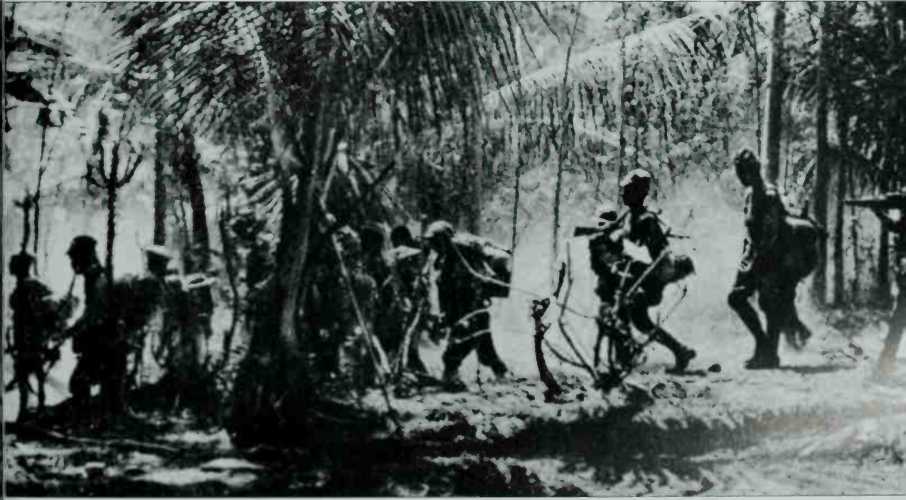Rations were boosted - and cut - for Britons on the home front throughout the war. Here is a typical weekly allowance per person.
8oz sugar, 3oz cheese 3oz cooking fat, 4oz bacon or ham 2oz jam, 2oz sweets, 2oz tea or coffee 1 egg, 3 pints milk, 11b meat
Bread, fish and sausages, although not rationed, were scarce. Although there was no restriction on fruit and vegetables, many were impossible to get. Lemons, bananas, onions and even pepper were rarely, if ever, seen during the war years in Britain.
Inventive housewives made chocolate truffle cake from potatoes, and banana pudding from parsnips.
Right: General-Marshal Homma makes an assisted landing on Luzon in the Philippines on 24 December 1941, ousting defending American troops.
The Japanese 14th Army quickly captured off-islands and made landings on Luzon, the largest Philippine island, as early as 10 December. There were continuing probes until the main landings, which took place on 22 December.
Coastal defences, comprising poorly trained and fearful Filipinos soon crumbled. A core of American troops was kept in the capital, Manila, by commander General MacArthur until it became clear that the defence of the island was an impossibility. He then ordered a withdrawal into the Bataan Peninsula in the hope the 31,000 troops could mount an adequate defence.
The Americans did manage to repel a number of raids. Then both sides became severely weakened through rampant malaria. Morale sank further in the American ranks when it became clear there was little or no effort being made to evacuate them. When the Japanese offensive began again on 3 April it took only six days to force a surrender.
There remained almost 15,000 Americans on the nearby island of Corregidor. The fight for this scrap of
Coastal defences, comprising poorly trained and fearful Filipinos, soon crumbled
An island was to be fierce. The Japanese carried out daily artillery bombardments across the straits from Luzon as well as waves of air attacks. When much of the American artillery had been knocked out, the
Japanese mounted an invasion with
2.000 troops. More than half were lost in the battle that ensued during the night of 5 May. But despite their losses, the Japanese managed to land some tanks, enough to crush the remaining resistance.
A surrender bid by American General Wainwright was hampered by guerrilla action adopted by the Americans. By 9 June, however, all resistance was crushed.
The loss to the Americans had been considerable; likewise to the native forces. A combined total of
95.000 were taken captive by the Japanese. Yet the defenders had held out for six months with no outside assistance, a significant achievement given the domino fall of islands in the rest of the area.
On paper, it appeared the British defenders of Malaya and neighbour-mg Singapore were more than a match for the invaders. There were about
100.000 Allied troops taking on just
30.000 incoming Japanese. In Britain there was confidence that Singapore particularly was a fortress with stout defences. It was unthinkable that the stronghold would be overrun. As so often happens during wars, the unthinkable happened - at speed.
The defeat of the British and Allied forces at the hands of the Japanese was a shocking one for which few at home were prepared. Yet there were shortcomings in the defences of the countries invaded which allowed the enthusiastic Japanese to run rampant.
Despite the signs of militarism evident in Japan, the British government remained convinced this small country would not take on the combined might of America, Britain and Russia. After the war, Churchill admitted he among others had underestimated the threat posed by Japan, particularly in its air power.
The Allies had no tanks with which to blast the enemy while the Japanese rolled over the inhospitable terrain with something in the order of 300. And while the Allies possessed more than twice the amount of artillery, much of it was in Singapore facing seawards to repel a southerly invasion. The Japanese flooded in from the opposite direction.
¦ OPPRESSIVE HEAT ¦
As for aircraft, the Allies had only a sixth of the number of aircraft that the Japanese had at their disposal. In a war which proved air might was imperative, the British were left seriously underequipped.
Moreover, Japanese troops were trained for jungle warfare and the dense vegetation and steamy atmosphere did not daunt them. The British and Australians were quickly wearied by the oppressive heat.
In command of the Japanese was General Tomoyuki Yamashita, a devoted servant of Kmperor Hirohito and a military marvel. Among his troops, he was known as ‘the tiger’. The Allies, meanwhile, were under General Arthur Percival, held with such low regard by his men that he was called ‘the rabbit’.
On the day that the prize British capital ships Prince of Wales and Repulse were sent to the bottom of the sea, Japanese forces marched into Malaya. With waves of air cover, they were quickly able to force the British down the Malay Peninsula in a rolling retreat. The highly organised invaders cut quickly through any defences they encountered. About
4,000 British troops and their equipment were stranded in central Malaya when Japanese tanks broke through their lines and seized a road
Below: Seasoned jungle warriors, the Japanese troops found far less difficulty operating in the tropics than their beiea-guered enemies did.





 World History
World History









